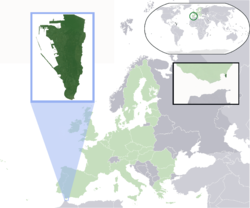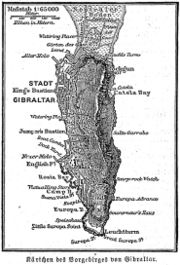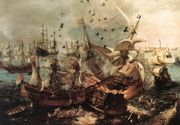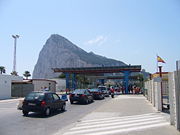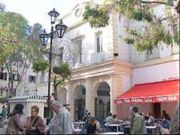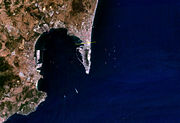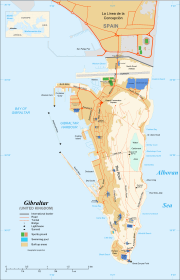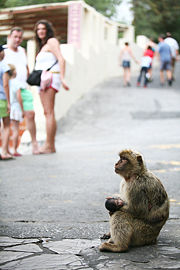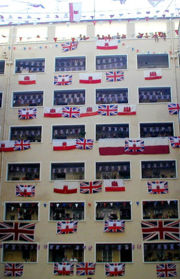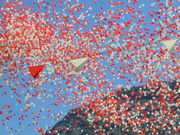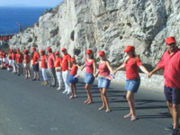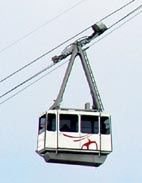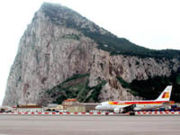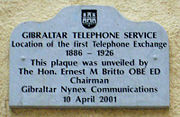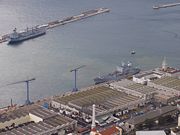Gibraltar
2008/9 Schools Wikipedia Selection. Related subjects: Geography of Great Britain
| Gibraltar | ||||||
|---|---|---|---|---|---|---|
|
||||||
| Motto: Nulli Expugnabilis Hosti (Latin) "No enemy shall expel us".1 |
||||||
| Anthem: Gibraltar Anthem Royal anthem: God Save the Queen |
||||||
|
|
||||||
| Capital (and largest city) |
Gibraltar |
|||||
| Official languages | English | |||||
| Unofficial languages Vernacular |
Spanish Llanito |
|||||
| Ethnic groups | Gibraltarian (of mixed Genoese, Maltese, Portuguese and Andalusian descent), other British, Moroccan and Indian | |||||
| Demonym | Gibraltarian | |||||
| Government | British Overseas Territory | |||||
| - | Head of state | Queen Elizabeth II | ||||
| - | Governor | Robert Fulton | ||||
| - | Chief Minister | Peter Caruana | ||||
| Event | Date | |||||
| - | Captured | 4th August 1704 | ||||
| - | Ceded | 11th April 1713 ( Treaty of Utrecht) | ||||
| - | National Day | 10th September | ||||
| - | Constitution Day | 29th January | ||||
| Area | ||||||
| - | Total | 6.8 km² ( 229th) 2.6 sq mi |
||||
| - | Water (%) | 0% | ||||
| Population | ||||||
| - | Jan 2008 estimate | 28,875 ( 207th) | ||||
| - | Density | 4,290/km² ( 5th) 11,154/sq mi |
||||
| GDP ( PPP) | 2005 estimate | |||||
| - | Total | $1066 million ( 197th) | ||||
| - | Per capita | $38,200 ( n/a) | ||||
| HDI (n/a) | n/a (n/a) ( n/a) | |||||
| Currency | Gibraltar pound £2 ( GIP) |
|||||
| Time zone | CET ( UTC+1) | |||||
| - | Summer ( DST) | CEST ( UTC+2) | ||||
| Internet TLD | .gi3 | |||||
| Calling code | [[+ 3504]] | |||||
| Patron saint | Bernard of Clairvaux & Our Lady of Europe | |||||
| 1 | National Symbols of Gibraltar | |||||
| 2 | Pegged with UK pound sterling at par. Coins and notes issued by the Government of Gibraltar. | |||||
| 3 | The .eu domain is also used, as it is shared with other European Union members. | |||||
| 4 | Before February 10, 2007, 9567 from Spain. | |||||
Gibraltar (IPA: /dʒɨˈbrɒltər/) is a British overseas territory located near the southernmost tip of the Iberian Peninsula overlooking the Strait of Gibraltar. The territory shares a border with Spain to the north. Gibraltar has historically been an important base for the British Armed Forces and is the site of a Royal Navy base.
The name of the territory is derived from the Arabic name Jabal Tāriq (جبل طارق), meaning "mountain of Tariq". It refers to the geological formation, the Rock of Gibraltar, which in turn was named for the Berber Umayyad general Tariq ibn-Ziyad who led the initial incursion into Iberia in advance of the main Moorish force in 711. Earlier, it was known as Mons Calpe, one of the Pillars of Hercules. Today, Gibraltar is known colloquially as Gib or The Rock.
A one-year investigation and analysis of 235 countries and territories by Jane’s Country Risk listed Gibraltar as the top stable and prosperous British Territory, in 5th position overall.
The sovereignty of Gibraltar has been a major issue of contention in Anglo-Spanish relations. Gibraltar was ceded by Spain to Great Britain in perpetuity, under the 1713 Treaty of Utrecht, though Spain asserts a claim to the territory and seeks its return. The overwhelming majority of Gibraltarians strongly oppose this, along with any proposal of shared sovereignty. The British government has stated that it is committed to respecting the Gibraltarians' wishes.
History
There is evidence of human habitation in Gibraltar going as far back as Neanderthal man, an extinct species of the Homo genus. The first historical people known to have settled there were the Phoenicians around 950 BC. Semi-permanent settlements were later established by the Carthaginians and Romans. After the collapse of the Roman Empire, Gibraltar came briefly under the control of the Vandals, and would later form part of the Visigothic Kingdom of Hispania until its collapse due to the Muslim conquest in 711 AD. At that time, Gibraltar was named as one of the Pillars of Hercules, after the legend of the creation of the Straits of Gibraltar.
On April 30, 711, the Umayyad general Tariq ibn Ziyad led a Berber-dominated army across the Strait from Ceuta. He first attempted to land at Algeciras but failed. Subsequently, he landed undetected at the southern point of the Rock from present-day Morocco in his quest for Spain. Little was built during the first four centuries of Moorish control.
The first permanent settlement was built by the Almohad Sultan Abd al-Mu'min, who ordered the construction of a fortification on the Rock, the remains of which are still present as the Moorish Castle. Gibraltar would later become part of the Kingdom of Granada until 1309, when it would be briefly occupied by Castillian troops. In 1333, it was conquered by the Marinids who had invaded Muslim Spain. The Marinids ceded Gibraltar to the Kingdom of Granada in 1374. Finally, it was reconquered definitively by the Duke of Medina Sidonia in 1462, ending 750 years of Moorish control.
In the initial years under Medina Sidonia, Gibraltar was granted sovereignty as a home to a population of exiled Sephardic Jews. Pedro de Herrera, a Jewish converso from Córdoba who had led the conquest of Gibraltar, led a group of 4,350 Jews from Córdoba and Seville to establish themselves in the town. A community was built and a garrison established to defend the peninsula. However, this lasted only three years. In 1476, the Duke of Medina Sidonia realigned with the Spanish Crown; the Sefardim were then forced back to Córdoba and the Spanish Inquisition. In 1501 Gibraltar passed under the hands of the Spanish Crown, which had been established in 1479. Gibraltar was granted its coat of arms by a Royal Warrant passed in Toledo by Isabella of Castile in 1501 which is still officially used today.
The naval Battle of Gibraltar took place on April 25, 1607 during the Eighty Years' War when a Dutch fleet surprised and engaged a Spanish fleet anchored at the Bay of Gibraltar. During the four-hour action, the entire Spanish fleet was destroyed.
During the War of the Spanish Succession, British and Dutch troops, allies of Archduke Charles, the Austrian pretender to the Spanish Crown, formed a confederate fleet and attacked various towns on the southern coast of Spain. On 4 August 1704, after six hours of bombardment starting at 5 am, the confederate fleet, commanded by Admiral Sir George Rooke assisted by Field Marshal Prince George of Hesse-Darmstadt comprising some 1800 Dutch and British marines captured the town of Gibraltar and claimed it in the name of the Archduke Charles. Terms of surrender were agreed upon, after which much of the population chose to leave Gibraltar peacefully.
Franco-Spanish troops failed to retake the town, and British sovereignty over Gibraltar was subsequently recognised by the 1713 Treaty of Utrecht, which ended the war. In this treaty, Spain ceded Gibraltar (Article X) and Minorca (article XI) to the United Kingdom in perpetuity. Great Britain has retained sovereignty over the former ever since, despite all attempts by Spain to recapture it.
Due to military incursions by Spain various fortifications were established and occupied by British troops in the area which came to be known as "the British Neutral Ground". This was the area to the north of Gibraltar, militarily conquered and continuously occupied by the British except during time of war. (The sovereignty of this area, which today contains the airport, cemetery, a number of housing estates and the sports centre, is separately disputed by Spain.)
During the American Revolution, the Spanish, who had entered the conflict against the British, imposed a stringent blockade against Gibraltar as part of an unsuccessful siege (the Great Siege of Gibraltar) that lasted for more than three years, from 1779 to 1783. On 14 September 1782, the British destroyed the floating batteries of the French and Spanish besiegers, and in February 1783 the signing of peace preliminaries ended the siege.
Gibraltar subsequently became an important naval base for the Royal Navy and played an important part in the Battle of Trafalgar. Its strategic value increased with the opening of the Suez Canal, as it controlled the important sea route between the UK and colonies such as India and Australia. During World War II, the civilian residents of Gibraltar were evacuated, and the Rock was turned into a fortress. An airfield was built over the civilian racecourse. Guns on Gibraltar controlled the entrance to the Mediterranean Sea, but plans by Nazi Germany to capture the Rock, codenamed Operation Felix, later named Llona, were frustrated by Spain's reluctance to allow the German Army onto Spanish soil and the excessive price Franco placed on his aid. Germany's Admiral Wilhelm Canaris, head of the Abwehr, also helped by filing a pointedly negative assessment of the options. A leader of the German high command resistance to Hitler, Canaris tipped off Franco, who erected concrete barriers on roads leading to the Pyrenees.
In the 1950s, Spain, then under the dictatorship of Francisco Franco, renewed its claim to sovereignty over Gibraltar, sparked in part by the visit of Queen Elizabeth II in 1954 to celebrate the 250th anniversary of the Rock's capture. For the next thirty years, Spain restricted movement between Gibraltar and Spain, in application of one of the articles of the Treaty. A referendum was held on September 10, 1967 (the Gibraltar sovereignty referendum, 1967), in which Gibraltar's voters were asked whether they wished to either pass under Spanish sovereignty, or remain under British sovereignty, with institutions of self-government. The vote was overwhelmingly in favour of continuance of British sovereignty, with 12,138 to 44 voting to reject Spanish sovereignty. This led to the granting of autonomous status in May 1969, which the Government of Spain strongly opposed. In response, the following month Spain completely closed the border with Gibraltar and severed all communication links.
In 1981 it was announced that the honeymoon for the royal wedding between Prince Charles and Diana Spencer would start from Gibraltar. The Spanish Government responded that King Juan Carlos and Queen Sofia had declined their invitation to the ceremony as an act of protest.
The border with Spain was partially reopened in 1982, and fully reopened in 1985 prior to Spain's accession into the European Community. Joint talks on the future of the Rock held between Spain and the United Kingdom have occurred since the late 1980s under the Brussels Agreement.
In 1988, SAS troops shot and killed three members of the IRA who were planning an attack on the British Army band. The ensuing "Death on the Rock" controversy prompted a major political row in the UK.
In July 2002 proposals for joint sovereignty with Spain were revealed by Jack Straw. A referendum was organised in Gibraltar in November 2002 (the Gibraltar sovereignty referendum, 2002) which rejected any idea of joint sovereignty by 17,900 (98.97%) votes to 187 (1.03%). The British Government restated that, in accordance with the preamble of the Constitution of Gibraltar:
The UK will never enter into arrangements under which the people of Gibraltar would pass under the sovereignty of another state against their freely and democratically expressed wishes.
The question of Gibraltar continues to affect British-Spanish relations.
September 2006 saw representatives of the United Kingdom, Gibraltar and Spain conclude talks in Córdoba, Spain, with a landmark agreement on a range of cross-cutting issues affecting the Rock and the Campo de Gibraltar removing some of the restrictions imposed by Spain. This agreement resolved a number of long standing issues; improved flow of traffic at the frontier, use of the airport by other carriers, recognition of the +350 telephone code and the settlement of the long-running dispute regarding the pensions of former Spanish workers in Gibraltar, who lost their jobs when Spain closed its border in 1969.
The Trilateral process is ongoing, and the British Government now states as policy that it will not enter into talks about sovereignty with Spain without the consent of the Government and people of the territory.
Politics
As Gibraltar is an overseas territory of the UK, the head of state is Queen Elizabeth II, who is represented by the Governor of Gibraltar. The UK retains responsibility for defence, foreign relations, internal security, and financial stability. The Governor is not involved in the day-to-day administration of Gibraltar, and his role is largely as a ceremonial representative of the head of state. The Governor officially appoints the Chief Minister and government ministers after an election. He is responsible for matters of defence, and security. On 17 July 2006, Governor Sir Francis Richards left Gibraltar on HMS Monmouth leaving the symbolic keys of the fortress of Gibraltar with the Deputy Governor. A new governor, Lt General Sir Robert Fulton KBE, replaced Sir Francis in September 2006.
The Government of Gibraltar is elected for a term of four years. The unicameral Parliament presently consists of seventeen elected members. The speaker is appointed by a resolution of the Parliament.
The head of Government is the Chief Minister, currently Peter Caruana. There are three political parties currently represented in the Parliament: the Gibraltar Social Democrats, the Gibraltar Socialist Labour Party, and the Gibraltar Liberal Party.
New Gibraltar Democracy and the Progressive Democratic Party have been formed since the 2003 election. The Reform Party was wound up and Gibraltar Labour Party absorbed into the GSD in a merger in 2005. A new party the Progressive Democratic Party PDP was formed in 2006.
The 2007 election was contested by the GSD, GSLP/LIBS, the PDP and two independents.
Gibraltar is a part of the European Union, having joined under the British Treaty of Accession (1973), with exemption from some areas such as the Customs Union and Common Agricultural Policy.
After a ten-year campaign to exercise the right to vote in European Elections, from 2004, the people of Gibraltar participated in elections for the European Parliament as part of the South West England constituency.
As a result of the continued Spanish claim, the issue of sovereignty features strongly in Gibraltar politics. All local political parties are opposed to any transfer of sovereignty to Spain. They instead support self-determination for the Rock. This policy is supported by the main UK opposition parties.
In March 2006, UK Foreign Secretary Jack Straw announced that a new Gibraltar constitution had been agreed upon and would be published prior to a referendum on its acceptance in Gibraltar that year. In July, in a statement to the UK Parliament, Geoff Hoon, the Minister for Europe, confirmed that the new Constitution confirms the right of self-determination of the Gibraltarian people.
On 30 November 2006, a referendum was held for a new constitution. The turnout was 60.4% of eligible voters of which 60.24% voted to approve the constitution and 37.75% against. The remainder returned blank votes. The acceptance was welcomed by the Chief Minister, Peter Caruana, as a step forward for Gibraltar's political development.
Geography

The territory covers 6.843 square kilometres (2.642 sq mi). It shares a 1.2 km (0.75 mi) land border with Spain. On the Spanish side is the town La Línea de la Concepción, a municipality of Cádiz province. The part of Cádiz province next to Gibraltar is called Campo de Gibraltar, literally Gibraltar Countryside. The shoreline measures 12 km (7.5 mi) in length. There are two coasts (sides) of Gibraltar – the East Side, which contains the settlements of Sandy Bay and Catalan Bay, and the West Side, where the vast majority of the population lives.
Having negligible natural resources and few natural freshwater resources, limited to natural wells in the north, until recently Gibraltar used large concrete or natural rock water catchments to collect water. Fresh water from the boreholes is supplemented by two desalination plants: a reverse osmosis plant, constructed in a tunnel within the rock, and a multi-stage flash distillation plant at North Mole.
Gibraltar is one of the most densely populated territories in the world, with approximately
4,290 inhabitants per square kilometre (11,100 /sq mi). The growing demand for space is being increasingly met by land reclamation; reclaimed land currently comprises approximately one tenth of the territory's total area.
The Rock itself is made of limestone and is 426 metres (1,396 ft) high. It contains many tunnelled roads, most of which are operated by the military and closed to the public.
Flora and fauna
Over 500 different species of flowering plants grow on The Rock. One of them, the Gibraltar candytuft ( Iberis gibraltarica), is endemic to Gibraltar. Among the wild trees that grow all around The Rock, olive and pine trees are some of the most common.
Most of its upper area is covered by a nature reserve, which is home to around 230 Barbary Macaques, commonly known as 'apes', the only wild monkeys found in Europe. They sometimes visit the town area. Recent genetic studies and historical documents point to their presence on the Rock before its capture by the British. A superstition analogous to that of the ravens at the Tower of London states that if the monkeys ever leave, so will the British. Other mammals found in Gibraltar include rabbits, foxes and bats. Dolphins and whales are frequently seen in the Bay of Gibraltar. Migrating birds are very common and Gibraltar is home to the only specimens of Barbary Partridges found on the European continent.
Climate
The climate is Mediterranean with mild winters and warm summers. There are two main prevailing winds, an easterly one known as the Levante coming from the Sahara in Africa which brings humid weather and warmer sea and the other as Poniente which is westerly and brings fresher air in and colder sea. Its terrain consists of the 1,396 foot (426 m) high Rock of Gibraltar and the narrow coastal lowland surrounding it.
| Month | Year | Jan | Feb | Mar | Apr | May | Jun | Jul | Aug | Sep | Oct | Nov | Dec |
|---|---|---|---|---|---|---|---|---|---|---|---|---|---|
| Avg high °C (°F) | 21 (70) | 16 (61) | 16 (62) | 17 (64) | 18 (66) | 21 (71) | 24 (76) | 27 (81) | 27 (82) | 26 (79) | 21 (71) | 18 (66) | 16 (62) |
| Avg low temperature °C (°F) | 15 (60) | 11 (52) | 11 (52) | 12 (54) | 13 (56) | 15 (60) | 17 (64) | 20 (68) | 20 (69) | 20 (68) | 16 (62) | 13 (57) | 12 (54) |
| Source: Weatherbase | |||||||||||||
Subdivisions
Gibraltar has no administrative divisions. It is, however, divided into seven Major Residential Areas, which are further divided into Enumeration Areas, used for statistical purposes.
The Major Residential Areas are listed below, with population figures from the Census of 2001:
| Residential area | Population | % of total | |
|---|---|---|---|
| 1. | East Side | 429 | 1.56% |
| 2. | North District | 4,116 | 14.97% |
| 3. | Reclamation Areas | 9,599 | 34.91% |
| 4. | Sandpits Area | 2,207 | 8.03% |
| 5. | South District | 4,257 | 15.48% |
| 6. | Town Area | 3,588 | 13.05% |
| 7. | Upper Town | 2,805 | 10.20% |
| Remainder | 494 | 1.79% | |
| Gibraltar | 27,495 | 100% |
Economy
The British military traditionally dominated the economy of Gibraltar, with the naval dockyard providing the bulk of economic activity. This has however diminished in the last twenty years, and it is estimated to account for only 7% of the local economy, compared to over 60% in 1984. Today, Gibraltar has an extensive service-based economy, dominated by financial services and tourism.
A number of British and international banks have operations based in Gibraltar. Recently, many bookmakers and online gaming operators have relocated to Gibraltar to benefit from operating in a regulated jurisdiction with a favourable corporate tax regime. However, this corporate tax regime for non-resident controlled companies is due to be phased out by 2010.
Tourism is also a significant industry. Gibraltar is a popular stop for cruise ships and attracts day visitors from resorts in Spain. The Rock is a popular tourist attraction, particularly among British tourists and residents in the southern coast of Spain. It is also a popular shopping destination, and all goods and services are VAT free. Many of the large British high street chains have branches in Gibraltar, including Marks and Spencer, BHS, Dorothy Perkins, and the supermarket Morrisons.
Figures from the CIA World Factbook show the main export markets in 2006 were United Kingdom 30.8%, Spain 22.7%, Germany 13.7%, Turkmenistan 10.4%, Switzerland 8.3%, Italy 6.7% while the corresponding figures for imports are Spain 23.4%, Russia 12.3%, Italy 12%, UK 9%, France 8.9%, Netherlands 6.8% and United States 4.7%.
The Gibraltar Government state that economy grew in 2004/2005 by 7% to a GDP of £599,180,000. Based on statistics in the 2006 surveys, the Government statisticians estimate it has grown by 8.5% in 2005/6 and by 10.8% in 2006/7 and that the GDP is probably now around 730 million. Inflation was running at 2.6% in 2006 and predicted to be 2% to 3% in 2007. Speaking at the 2007 budget session, Peter Caruana, the Chief Minister said "The scale of Gibraltar's economic success makes it one of the most affluent communities in the entire world."
Currency
The Currency Notes Act confers on the Government of Gibraltar the right to issue its own currency notes, at parity with pound sterling. The monetary unit of Gibraltar is described both as "pound sterling" and also referred to as the "Gibraltar pound". The ISO code "GIP" is assigned to the Gibraltar pound. Government of Gibraltar notes in circulation bear the words "Pounds sterling" and are legal tender in Gibraltar, but not in the United Kingdom or the other territories of the Sterling Area. Sterling currency notes issued by the Bank of England are legal tender and are in circulation in Gibraltar alongside the local note issues. The euro is unofficially accepted in Gibraltar, though not by post offices or all payphones.
Demographics
The population of Gibraltar was 27,967 in July 2007.
Gibraltarians are a racial and cultural fusion of the many European immigrants who came to the Rock over three hundred years. They are the descendants of economic migrants that came to Gibraltar after the majority of the Spanish population left in 1704. The few Spaniards who remained in Gibraltar in August 1704 were augmented by others who arrived in the fleet with Prince George of Hesse, possibly some two hundred in all, mostly Catalans. By 1753 Genoese, Maltese, and Portuguese people formed the majority of this new population. Other groups include Minorcans (forced to leave their homes when Minorca was returned to Spain in 1802), Sardinians, Sicilians and other Italians, French, Germans, and the British. Immigration from Spain and intermarriage with Spaniards from the surrounding Spanish towns was a constant feature of Gibraltar's history until General Francisco Franco closed the border with Gibraltar, cutting off many Gibraltarians from their relatives on the Spanish side of the frontier. The Spanish socialist government reopened the land frontier, but other restrictions remain in place.
Religion
Gibraltar's main religion is Christianity, with the majority of Gibraltarians belonging to the Roman Catholic Church. Other Christian denominations include the Church of England, whose Cathedral of the Holy Trinity is the cathedral of the Bishop of Gibraltar in Europe; the Gibraltar Methodist Church, Church of Scotland, various Pentecostal and independent churches mostly influenced by the House Church and Charismatic movements, as well as a Plymouth Brethren congregation. There is also a ward of The Church of Jesus Christ of Latter-day Saints, and Jehovah's Witnesses. There are also a number of Hindu Indians, a Moroccan Muslim population, members of the Bahá'í Faith and a long-established Jewish community.
Language
As a British overseas territory, the sole official language of Gibraltar is English, and it is used by the Government and in schools. Most locals are bilingual, also speaking Spanish, due to Gibraltar's proximity to Spain. However, because of the varied mix of ethnic groups which reside there, other languages are spoken on The Rock. Arabic is spoken by the Moroccan community, as are Hindi and Sindhi by the Indian community of Gibraltar. The Maltese language is still spoken by some families of Maltese descent.
Most Gibraltarians converse in Llanito (pronounced [jɑˈnito] or [ʒɑˈnito]). It is an Andalusian Spanish based creole and is the main local vernacular, and unique to Gibraltar. It consists of an eclectic mix of Andalusian Spanish and British English as well as languages such as Maltese, Portuguese, Italian of the Genoese variety and Haketia. Andalusian Spanish is the main constituent of Llanito, but is also heavily influenced by British English. However, it borrows words and expressions of many other languages, with over 500 words of Genoese and Hebrew origin. Among more educated Gibraltarians, it also typically involves code-switching to English.
Gibraltarians also call themselves Llanitos.
Education
Education in Gibraltar generally follows the English system operating within a three tier system. Schools in Gibraltar follow the Key Stage system which teaches the National Curriculum.
Schools
Gibraltar has fifteen state schools, one MOD school, one private school and one College of Further Education.
Higher education
As there are no facilities in Gibraltar for full-time higher education, all Gibraltarian students must study elsewhere at degree level or equivalent and certain non-degree courses. The Government of Gibraltar operates a scholarship/grant system to provide funding for students studying in the United Kingdom. All Gibraltarian students follow the student loans procedure of the UK, where they apply for a loan from the Student Loans Company which is then reimbursed in full by the Government of Gibraltar.
Health care
All Gibraltarians are entitled to free health care in public wards and clinics at the hospital and primary health care centre. All other British citizens are also entitled to free of charge treatment on the Rock on presentation of a valid British passport during stays of up to 30 days. Other EU nationals are equally entitled to treatment on presentation of a valid European Health Insurance Card. Dental treatment and prescribed medicines are also free of charge for Gibraltarian students and pensioners.
General hospitals
- St Bernard's Hospital
Primary health care centres
- Health Care Centre
Mental hospitals
- King George V Hospital
Culture
The culture of Gibraltar reflects Gibraltarians' diverse origins. While there are Andalusian and British influences, the ethnic origins of most Gibraltarians are not confined to British or Andalusian ethnicities. Most ethnicities include Genoese, Maltese, Portuguese, and German. A handful of other Gibraltar residents are Jewish of Sephardic origin, North African, or Indians.
British influence remains strong. English is the language of government, commerce, education, and the media. Gibraltarians going on to higher education attend university in the UK. Patients requiring medical treatment not available on the Rock receive it as private patients paid for by the Gibraltar Government either in the United Kingdom, or more recently in Spain.
There exists a small but interesting amount of literary writings by native Gibraltarians. The first prominent work of fiction was probably Héctor Licudi's 1929 novel Barbarita, written in Spanish. It is a largely autobiographical account of the adventures and misadventures of a young Gibraltarian man. Throughout the 1940s and 1950s, several noteworthy anthologies of poetry were published by Leopoldo Sanguinetti, Albert Joseph Patron, and Alberto Pizzarello. The 1960s were largely dominated by the theatrical works of Elio Cruz and his two highly acclaimed Spanish plays La Lola se va pá Londre and Connie con cama camera en el comedor. In the 1990s, the Gibraltarian man-of-letters Mario Arroyo published Profiles (1994), a series of bilingual meditations on love, loneliness and death. Of late there have been interesting works by the essayist Mary Chiappe such as her volume of essays Cabbages and Kings (2006) and by the UK-educated academic M. G. Sanchez, author of the hard-hitting novel Rock Black 0-10: A Gibraltar fiction (2006).
Cuisine
Gibraltarian cuisine is the result of a long relationship between the Andalucian Spaniards and the British, as well as the many foreigners who made Gibraltar their home over the past three centuries. The culinary influences include those from Malta, Genoa, Portugal and Andalusia. This marriage of tastes has given Gibraltar an eclectic mix of Mediterranean and British cuisine.
Music
The music of Gibraltar is undergoing a renaissance with a multitude of local bands playing original material and covers. Local venues have begun accepting Gibraltarian bands and those from nearby Spain, resulting in a varied mix of live performances every weekend as well as some weekday nights.
Musicians from Gibraltar include Charles Ramirez, the first guitarist invited to play with the Royal College of Music Orchestra, and successful rock bands like Breed 77, Melon Diesel and Taxi.
The best known Gibraltarian musician is Albert Hammond, who has had top 10 hits in the UK & US, and has written many songs for international artists such as Whitney Houston, Tina Turner and Julio Iglesias among many others.
National Day
Gibraltar's National Day commemorates the 1967 referendum when the people of Gibraltar voted to reject Spanish sovereignty or association by a massive majority. It is celebrated annually on September 10. The day is a public holiday, during which most Gibraltarians dress in the national colours of red and white and among other events, attend a rally. The rally culminates with the release of 30 000 red and white balloons representing the people of Gibraltar.
The Conservative MP Andrew Rosindell described the event as "a magnificent celebration of the Gibraltarian people, showing not only their pride in being British, but also their love of their homeland — the rock itself"
Tercentenary
In 2004, Gibraltar celebrated the tercentenary (the 300th anniversary) of its capture by British forces. In recognition of and with thanks for its long association with Gibraltar, the Royal Navy was given the freedom of the City. Another event saw nearly the entire population, dressed in red, white and blue, link hands to form a human chain encircling the Rock.
Sport
In 2007 there were eighteen Gibraltar Sports Associations with official recognition from their respective International Governing Bodies. Others, including the Gibraltar National Olympic Committee, have submitted applications for recognition which are being considered.
Cricket enjoys massive popularity in Gibraltar as the weather is perfectly suited to cricket games. The Gibraltar national cricket team recently won the European Cricket Championships.
The Government supports the many sporting associations financially. Gibraltar also competes in the bi-annual Island Games, which it hosted in 1995.
The Gibraltar Football Association applied for full membership of UEFA, but their bid was turned down in 2007 in a contentious decision.
Transport
Within Gibraltar, the main form of transport is the car. Motorbikes are popular and there is a good modern bus service. Unlike in other British territories, traffic drives on the right, as the territory shares a land border with Spain.
There is a cable car which runs from ground level to the top of the rock, with an intermediate station at the apes’ den.
Restrictions on transport introduced by the Spanish dictator Francisco Franco closed the land frontier in 1969 and prohibited any air or ferry connections. In 1982, the land border was reopened. As the result of an agreement signed in Cordoba on September 18, 2006 between Gibraltar, the United Kingdom and Spain, the Spanish government agreed to relax the border controls at the frontier that have plagued locals for decades; in return, Britain will pay increased pensions to workers who lost their jobs when Franco closed the border. Restrictions on telephones were removed in 2007 and restrictions on movements at the airport were removed on 16 December 2006.
Gibraltar maintains regular flight connections to London and Madrid. Scheduled flights to Morocco and other UK destinations were cancelled after insufficient demand to sustain the services.
GB Airways has operated a service between Gibraltar and London and other cities for many years. The airline initially flew under the name "Gibraltar Airways." In 1989, and in anticipation of service to cities outside the UK, Gibraltar Airways changed its name to GB Airways with the belief that a new name would incur fewer political problems. As one of British Airways' franchise operators, the airline now operates flights in full British Airways livery. In 2007 GB Airways was purchased by EasyJet who operate flights under their name from April 2008 when British Airways re-introduced flights to Gibraltar under their name. Monarch Airlines operate a daily scheduled service between Gibraltar and Luton. From September 2008 they will also operate a scheduled service to Manchester, UK. The Spanish national airline, Iberia, operates a daily service to Madrid. An annual return charter flight to Malta is operated by Maltese national airline, Air Malta.
Gibraltar Airport is unusual not only due to its proximity to the centre of the city resulting in the airport terminal being within walking distance of much of Gibraltar but also because the runway intersects Winston Churchill Avenue, the main north-south street, requiring movable barricades to close when aircraft land or depart. New roads and a tunnel for Winston Churchill Avenue, which will end the need to stop road traffic when aircraft use the runway, are planned with a completion date of 2009.
Motorists, and on occasion pedestrians, crossing the border with Spain have been subjected to long delays and searches by the Spanish authorities. Spain has closed the border during disputes or incidents involving the Gibraltar authorities, such as the Aurora cruise ship incident and when fishermen from the Spanish fishing vessel Pirana were arrested for illegal fishing in Gibraltar waters.
Communications
Gibraltar has a digital telephone exchange supported by a fibre optic and copper infrastructure. The telephone operator, Gibtelecom, also operates a GSM network.
International subscriber dialling is provided, and Gibraltar was allocated the access code 350 by the International Telecommunication Union. This works from all countries with IDD, including Spain, which has accepted its use since February 10, 2007, when the telecom dispute was resolved. Gibraltar fixed service numbers are currently five digits but are being increased to eight by adding the prefix 200 to existing lines.
Dial-up, ADSL, high-speed Internet lines are available, as are some wifi hotspots in hotels. Local operator CTS is rolling out WiMax.
The Gibraltar Broadcasting Corporation operates a television and radio station on UHF, VHF and medium-wave. The radio service is also Internet-streamed. Special events are streamed in video.
The largest and most frequently published newspaper is the Gibraltar Chronicle, Gibraltar’s oldest established daily newspaper and the world’s second oldest English language newspaper to have been in print continuously with daily editions six days a week. Panorama is published on weekdays, and Vox, 7 Days, The New People, and Gibsport are weekly.
Military
Gibraltar's defence is the responsibility of the tri-service British Forces Gibraltar. The army garrison is provided by the Royal Gibraltar Regiment, originally a part-time reserve force which was placed on the permanent establishment of the British Army in 1990. The regiment includes full-time and part-time soldiers recruited from Gibraltar, as well as British Army regulars posted from other regiments.
The Royal Navy maintains a squadron at the Rock. The squadron is responsible for the security and integrity of British Gibraltar Territorial Waters (BGTW). The shore establishment at Gibraltar is called Rooke after Sir George Rooke who captured the Rock for Archduke Charles (pretender to the Spanish throne) in 1704. Gibraltar's strategic position provides an important facility for the Royal Navy and Britain's allies. Ships from the Spanish Navy do not call at Gibraltar.
British and U.S. nuclear submarines frequently visit the Z berths at Gibraltar. A Z berth provides the facility for nuclear submarines to visit for operational or recreational purposes, and for non-nuclear repairs.
The Royal Air Force station at Gibraltar forms part of Headquarters British Forces Gibraltar. Although aircraft are no longer permanently stationed at RAF Gibraltar, a variety of RAF aircraft make regular visits to the Rock and the airfield also houses a section from the Met Office.
The Rock is believed to be a SIGINT listening post. Its strategic position provides a key GCHQ and National Security Agency location for Mediterranean and North African coverage.
During the Falklands War, an Argentine plan to attack British shipping in the harbour using frogmen ( Operation Algeciras) was foiled. The naval base also played a part in supporting the task force sent by Britain to recover the Falklands.
In January 2007, the Ministry of Defence announced that services to the base would be provided by the private company SERCO, resulting in industrial action from the trade unions involved.
Death on the Rock
On March 6, 1988, as part of Operation Flavius, the British SAS killed three members of the Provisional Irish Republican Army (IRA) in Gibraltar. The three, Mairéad Farrell, Sean Savage, and Daniel McCann, were there on an IRA operation to plant a car bomb. All three were unarmed at the time, but a car they had hired was subsequently discovered in Spain with 64 kg (141 lb) of Semtex explosive. The incident became the subject of a contentious Thames Television documentary, Death on the Rock.
An inquest was held which ruled the SAS's action to be lawful. The families of the deceased, however, took the case to the European Court of Human Rights, and in 1995 it held by ten votes to nine that the British government had violated Article 2 of the European Convention on Human Rights. It also ruled, however, that the three killed had been engaged in an act of terrorism, consequently dismissing unanimously the applicants' claims for damages, for costs and expenses incurred by the original inquest, and for any remaining claims for just satisfaction.
Gibraltar in popular culture
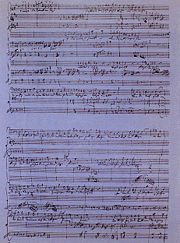
Film
- The film The Silent Enemy was filmed on location in Gibraltar in 1958. It is a dramatisation of the period during the Second World War when Lionel "Buster" Crabb served as a mine and disposal officer in Gibraltar while frogmen of the Italian Navy's Tenth Light Flotilla were sinking vital shipping.
- The opening scene of the film The Living Daylights (from the James Bond film series) takes place in Gibraltar.
- In the German-language film Das Boot, a German U-boat struggles in its attempt to get past the British navy in Gibraltar to relocate to a base in the Mediterranean sea.
Literature
- Anthony Burgess's novel A Vision of Battlements (1965), chronicling the troubled love-life of the British soldier Richard Ennis, is set in Gibraltar.
- The satirical novel Gil Braltar by Jules Verne (1887) describes an almost successful attack of the monkeys on the fortress.
- "The Day of an American Journalist in 2889", an 1889 Jules Verne short story, also mentions Gibraltar as the last territory of a British Empire that has lost the British Isles themselves.
- Raffles' Crime in Gibraltar by Barry Perowne, a Sexton Blake story set in Gibraltar in 1937 (U.S. title: They Hang Them in Gibraltar).
- Scruffy by Paul Gallico is set on Gibraltar during World War II. It follows the steady decline in the size of the Macaque colony and the possible fulfilment of the superstition that Gibraltar will fall if it disappears.
- As Molly Bloom is a native Gibraltarian, references to Gibraltar appear throughout James Joyce's Ulysses (1922). A sculpture of Molly Bloom as imagined by local artist Jon Searle is on display in the Alameda Gardens.
- Arthur C. Clarke's novel The Fountains of Paradise mentions about the ' Gibraltar Bridge', a novel infrastructure connecting Europe and Africa.
- John Masters' book The Rock is a collection of short stories set in Gibraltar: ranging from a story set in prehistoric times to one suggesting a possible future for the Rock.
Music
- In 1782 Wolfgang Amadeus Mozart composed a fragment for voice and piano to celebrate the Great Siege of Gibraltar titled Bardengesang auf Gibraltar: O Calpe! Dir donnert's am Fusse.
- The Beatles' song The Ballad of John & Yoko identifies Gibraltar as the place that John Lennon and Yoko Ono were married.
Notable people from Gibraltar
Notable or famous Gibraltarians include:
- William George Penney - physicist responsible for the development of British nuclear technology following World War II.
- John Galliano - four time British fashion designer of the year.
- Albert Hammond - International singer, songwriter and producer.
- Henry Francis Cary (1772 - 1844) - Translator and poet.
- Thomas William Bowlby (1818 - 1860) - Correspondent for The Times in Germany and China. He was captured and imprisoned by the Tartar General Sengge Rinchen whilst on correspondence in Tongzhou, Beijing.
- Frederick Stanley Maude (1864 - 1917) - General who led the successful campaign in World War I to capture Baghdad over the winter of 1917.
- John Beikie (1766 - 1839) - Merchant and political figure in Upper Canada.
- Don Pacifico (1784 - 1854) - Gibraltar-born Portuguese Jew, most famous for the Pacifico incident
- John Montresor (1736 - 1799) - Gibraltar-born military engineer in the British service active in North America, his amorous exploits inspired the best-selling novel Charlotte Temple.
- Gustavo Bacarisas (1873-1971) - Painter.
Twin towns
- Goole, Yorkshire and the Humber, UK (1969, but lapsed)
- Ballymena, United Kingdom (Northern Ireland) (2006)


